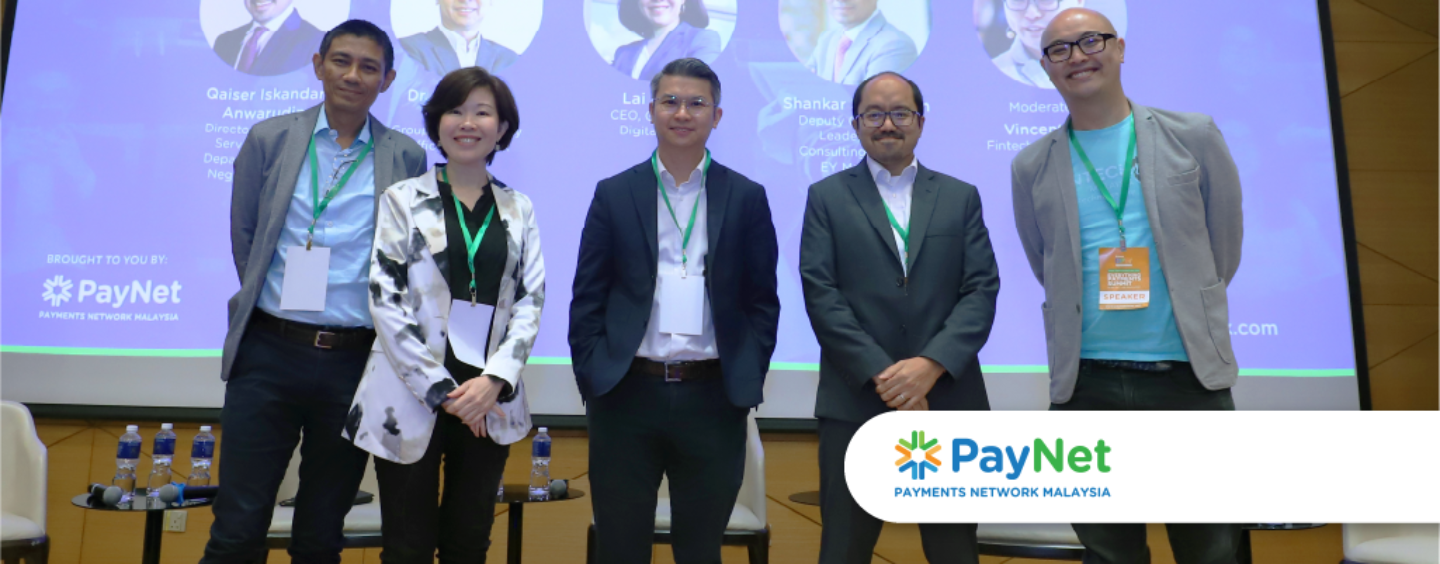The digital payments industry has witnessed significant growth and transformation in recent years, driven by technological advancements, changing consumer behaviour, and evolving regulatory landscapes.
To explore the path forward, a panel discussion was held during the Everything Payments Summit as a part of PayNet Digital Payments Week 2023, featuring notable industry leaders Qaiser Iskandar Anwarudin, Director of the Payments Services Policy Department at Bank Negara Malaysia; Dr. Siew Chan Cheong, Group Chief Strategy Officer at Maybank; Lai Pei Si, the CEO Designate of Grab Malaysia digital bank; and Shankar Kanabiran, Deputy Consulting Leader & FS Consulting Leader at EY Malaysia.
Moderated by Fintech News Malaysia Chief Editor Vincent Fong, the panellists shared their insights on the industry’s progress, the necessary collaboration between stakeholders, and the shared vision required to shape the future of digital payments.
Contributions to the digital payments industry
Qaiser said the exciting growth of domestic payments in Malaysia, citing increased consumer confidence in e-payments and improved accessibility for merchants. He highlighted the entry of new players and the forthcoming digital banks, which will fuel competitiveness and benefit consumers. He also mentioned the importance of cross-border payments and how bodies like ASEAN can facilitate seamless integration and collaboration among regional economies.

The Everything Payments Summit at PayNet Digital Payments Week 2023
Dr. Siew pointed out the need to deepen the penetration of digital payments, especially in non-urban areas. He highlighted the role of Maybank’s extensive physical footprint and branch network in guiding customers toward digital payment adoption. Dr. Siew also mentioned the emergence of embedded finance and collaboration with governments to foster innovative solutions for inclusive digital payment ecosystems.
GXS Grab’s Pei Si discussed the advancements in fraud detection and security measures within digital payment systems. She emphasised the importance of maintaining robust data security standards and compliance with standards like PCI DSS. Pei Si also stressed the significance of customer support and a proactive approach to fraud detection to ensure a seamless and secure payment experience for users.
Shankar focused on the evolving business models in the digital payments industry. He highlighted the increasing diversity of payment models, such as peer-to-peer transactions and bank loans, which present new opportunities for growth. Shankar also emphasised the role of research and development in driving innovation and adapting to evolving customer needs.
Collaboration and education
To propel the digital payments industry forward, collaboration among stakeholders is crucial. The panellists emphasised the need for cooperation between regulatory bodies, financial institutions, fintech companies, and other industry players. By working together, they can establish common standards, foster innovation, and address challenges related to security, interoperability, and customer experience.
A shared vision is essential to guide the industry’s development, the panellists agreed, pointing to several key building blocks required including robust security and compliance, innovation and research, as well as collaborations and partnerships between industry players and the rest of the digital payments ecosystem.

Shankar Kanabiran
The panellists stressed the importance of education in combating social engineering and raising awareness about the risks associated with digital payments. By educating users about best practices and potential threats, the industry can empower individuals to make informed decisions and protect themselves from fraud.
Shankar Kanabiran emphasised the critical role of education in fostering awareness at all levels, starting from primary education. By instilling digital literacy from a young age, individuals can develop a better understanding of digital payment systems and security measures.
Shankar added that organisations should adopt a “secure by design” approach, ensuring that security measures are integrated into every aspect of the customer journey. Moreover, maintaining a strong partnership with reputable suppliers and treating them as an extension of the organisation’s security efforts is essential.
BNM’s approach to CBDCs
The discussion also touched upon the role of central bank digital currencies (CBDCs) in the future of payments. The panellists acknowledged that CBDC experiments are taking place globally, with over 114 countries exploring or piloting CBDC initiatives. However, the use cases and value proposition of CBDCs, particularly in the retail space, are still being evaluated.
Shankar highlighted that the value proposition of CBDCs is more apparent in wholesale payments, where inefficiencies exist in trade settlements and cross-border transactions. While retail CBDCs may not offer significant differentiation in the current landscape, the panellists agreed that continuous monitoring and assessment of CBDC developments are necessary to identify potential opportunities and adapt to emerging trends.

Qaiser Iskandar Anwarudin
Bank Negara Malaysia has embarked on a multi-year CBDC exploration project, initially focusing on wholesale CBDC in the context of cross-border payments, according to BNM director Qaiser. However, challenges related to access, governance, commercial viability, and regulatory harmonisation remain important considerations.
Moving forward, BNM is exploring the application of wholesale CBDC for domestic settlement. This phase aims to understand how distributed ledger technology (DLT) underlying CBDCs can future-proof the country’s financial market infrastructure. Collaboration between the public and private sectors is crucial, as partnerships will drive innovation and determine the potential use cases of CBDCs.
The role of digital banks
Moderator Vincent Fong directed a question to the panelists about the entry of digital banks and its impact on the payment space. Dr. Siew from Maybank highlighted that rather than seeing other banks as competitors, they view them as partners and institutions to learn from. He placed importance on technology innovation and leveraging the latest advancements to build resilient platforms, enhance client experiences, and streamline operations.

Lai Pei Si
Pei Si outlined three key areas where digital banks can make an impact. Firstly, technology innovation allows digital banks to adopt the best and latest tech solutions, unencumbered by legacy systems, resulting in improved resilience and enhanced user experiences. Secondly, by targeting specific customer segments, particularly those that are underserved or have unique needs, digital banks can design tailored processes and utilise the right technology to meet their requirements effectively.
Lastly, Pei Si emphasised the significance of data. Digital banks have the advantage of starting from scratch and building data-driven strategies, enabling them to leverage both internal and ecosystem data to enhance customer experiences and drive innovation. The flexibility provided by the licensing framework allows digital banks to test and learn, which can potentially lead to new and improved offerings.
Consumer benefits and regulatory focus
Vincent acknowledged that at the end of the day, the consumer is the ultimate winner in the evolving digital payments landscape. He cited the example of Hong Kong, where the entry of new digital banks led to increased competition and higher interest rates for customers. The competition between incumbents and challengers ultimately benefits the Malaysian population by providing more options and improved services.
Regarding the regulatory focus, Qaiser highlighted the importance of effective management of fraud and scams as a priority for BNM. The regulatory framework aims to preserve confidence in the financial system, and efforts will be made to detect and address fraudulent activities proactively. Additionally, there will be a continued focus on raising awareness and promoting financial education among the public.
Looking ahead, the central bank will continue to refine its regulatory framework to support innovation while managing potential risks. Measures such as enhancing the regulatory sandbox and E-KYC guidelines are part of ongoing efforts to foster responsible innovation. The focus on financial market infrastructures will also ensure that the payment systems can effectively support the economy and the financial sector.
The role of ESG and open payments
During the Q&A session, the panellists addressed questions about the role of ESG (Environmental, Social, and Governance) principles in the digital payments landscape. Pei Si from GXS Grab Digital Bank highlighted the concept of ethical banking, where principles of sustainability and social responsibility are integrated into product design and customer offerings. Dr. Siew Chan Cheong of Maybank also emphasised the importance of ESG and ethical considerations in their approach to banking.

Dr. Siew Chan Cheong
During the Q&A session, a question was raised regarding the implementation of open payments on highways, allowing customers to use their debit and credit cards at toll plazas. The panellists shared their thoughts on this development, considering both the customer experience and operational aspects.
Dr. Siew acknowledged the importance of open payments, highlighting the benefits for consumers in terms of choice and convenience. He stressed the need for industry collaboration to support the government’s initiatives in promoting open payments. The panellists agreed that giving customers more options for payment methods is a positive step forward.
Shankar added that from a consumer perspective, open payments provide greater choice and flexibility. However, she noted that the industry will need to react to this change and ensure that the necessary infrastructure is in place to support seamless transactions. While there may be initial concerns about transaction speed, Shankar expressed confidence that the industry will work towards upgrading the infrastructure to provide a smooth and efficient experience for customers.
The introduction of open payments on highways will not only benefit consumers but also create opportunities for financial institutions to better serve their customers. As the industry adapts to this shift, they will strive to enhance the value proposition and offer a seamless payment experience.








